As an Amazon Associate I earn from qualifying purchases.
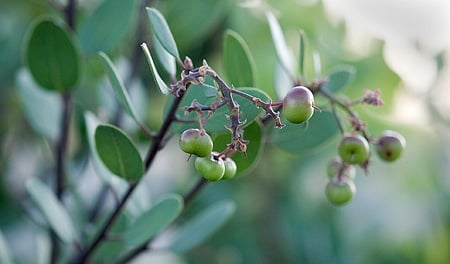
If you live in the West, you’ve seen the mystical manzanita: It is a captivating shrub, if such a thing can be said with a straight face.
Manzanita leaves are perfect ovals, thick to hold in moisture and colored a luminous, silvery green; under the full moon, the leaves glow eerily. But it’s the wood that is so unique: Bright red and gnarled, when the bush grows into its adulthood, its bark will burst and flake off like the aftermath of a bad sunburn.
Come upon a manzanita in spring and you could be forgiven for mistaking it for a weird blueberry bush. It’s not, as manzanita is in the arctostaphylos, not the vaccinium clan, but both shrubs have very similar urn-shaped flowers.
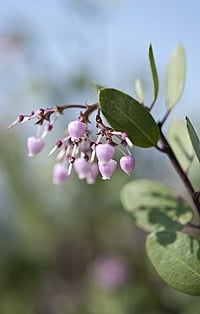
Come upon a manzanita later in summer and you will understand its name: Manzanita means “little apple” in Spanish. Look at the top picture: They really do look like little apples.
Ever since I moved to California I’d read that the berries were quasi-edible, that someone — Indians or Spaniards — did something with them at some point. I even bought a couple of manzanita bushes to plant in that blast furnace I call my front yard. But I bought them because manzanita is a beautiful bush, not because I had designs on the berries.
That was a decade ago. My bushes are big and beautiful, and they set many hundreds of “little apples” every year. What to do with them? As it happens, the Franciscan friars, who were the first European settlers of California, made a sort of cider from the berries. The California Indians did the same thing, plus they made a meal from the dried, ripe berries they’d later use for porridge in winter.
Cider, eh? I like cider. But really? I’d eaten a berry or two, and I can tell you manzanita is definitely not something to munch on while walking a trail. The unripe berries are loaded with tannin, which sucks all the moisture from your mouth and replaces it with a coating of felt — or at least it feels that way. The red berries do get nice and sweet, but they are powdery dry and you need to not eat the seeds, which are hard as rocks; the powder does remind of of Pixie Stix from my childhood, though…
There is very little information on manzanita as an edible plant. Charlotte Bringle Clarke mentions it in her excellent book Edible and Useful Plants of California, as does Sylvia Ross in her book Seaweed, Salmon, and Manzanita Cider: A California Indian Feast.
Opinions and instructions vary wildly. Best I can suss out, the Spaniards liked the berries greenish, while the Indians waited until they were brown and dry. Being of European descent, I decided on picking my manzanita berries green, but with a little rosy blush on them.

I got four cups from one bush, and I did not even pick it clean. Definitely enough to play with.
The berries are dry. So I first decided to boil them for 20 minutes, then smash them with a potato masher. I then let this cool overnight and poured it into a Mason jar. I let the solids settle for a day. Next day I poured off the liquids through cheesecloth into a clean Mason jar. I noticed a lot of fine sludge. I tasted it. Ack! Pure tannin, dry and bitter.
I tasted the cider. Um, ick. It was just like the sludge. Undrinkable. But, there was hope embedded in the loss: I could definitely taste an apple-y, acidic flavor that was indeed tasty — before the tannins clubbed me in the forehead.
Back to the drawing board. I thought, hmmm… If you boil sumac, you get the same bitterness. Sumac “lemonade” is made by just pouring room temperature water on the berries. Now manzanita is way too hard to do this, so I compromised by pouring boiling water on the berries, letting it steep for 20 minutes, and then smashing them with a potato masher.
After an overnight steep, I put everything back into a Mason jar.
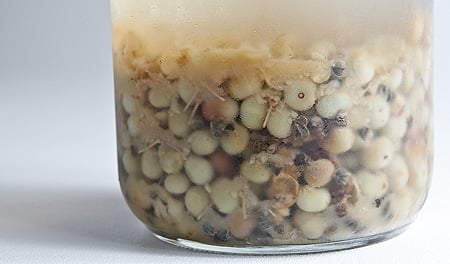
I strained this through cheesecloth and took a sip. Bingo! Light, crisp, just a tiny bit tannic, and even ever-so-slightly sweet. It tastes disturbingly like a non-carbonated hard cider or a Pinot Grigio, only without the alcohol. You can sweeten this if you’d like, but I like it as-is.
So, here’s what you need to know to make manzanita cider:
- For a white cider, pick the berries when they are blushing, late June in the lowlands, September in the high Sierra. You want them green with a bit of blush, at least where the berries have been exposed to the sun; berries in full shade won’t get the blush. For a pink cider, wait until the berries are fully red and dry.
- Wash the berries, which will be dusty and might have cobwebs and other debris on them.
- Your ratio is 1 cup manzanita berries to 4 cups water.
- Boil the water and pour it over the berries. Wait 20 minutes.
- Crush the berries with a potato masher. Don’t wail on them, just bruise and lightly break the berries.
- Let this steep at room temperature overnight.
- The next day, pour the cider through a fine sieve into a mason jar. Now do it again, this time through cheesecloth. Save the berries, because you can make another batch of cider with them. Now let your cider sit in the fridge overnight. More sediment will fall to the bottom. Carefully decant the good cider from the jar, leaving as much of the fine sediment in the original jar as possible. The sediment is loaded with tannins, so you want it out of your cider.
- Drink some. It will taste a little like a dry hard cider. Sweeten to taste for a cooling drink. I’ve added 2 tablespoons of sugar for every pint of cider, but I often just drink it plain.
Can you do something with manzanita cider other than drink it? You bet. Mix it with an equal volume of sugar to make manzanita syrup. You can then make ice cream, sorbet, or just use it as a concentrate for a cooling drink.
Where can you find manzanita? You’ll find these bushes growing in great profusion in the Sierra Nevada of California, but various species will grow as far north as British Columbia and as far east as Texas. They are, for the most part, lovers of arid places. It doesn’t matter which species you come across – all manzanita berries are edible. I should note that a few species of manzanita are endangered, so pick from large masses of the plants, not isolated individuals.
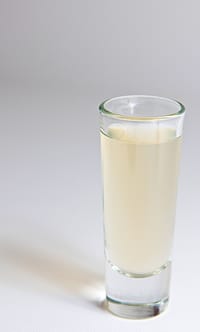
Is the drink worth this effort? I’d say yes. Manzanita is all over the place out there, and the berries store really well in the fridge, up to 2 months. Some will burst and release their little black seeds, but no biggie. I have had no mold problems, and the cider tasted just as good as when fresh-picked. The drink is really quite elegant-tasting. I’d be proud to serve it in a wineglass to someone who does not drink alcohol — or, for those who partake, mixed with vodka. Manza-tini, anyone?



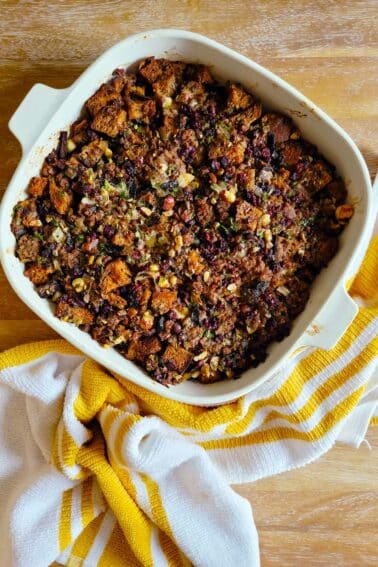
Many years ago, we used to make a savory Manzanita Jelly and sell it for fundraisers at my old hippy grade school. Seriously good stuff,
~M
I don’t believe we have a lot of manzanita up here in Oregon. An edible wild plant we have here (and I believe you’ve got them in CA too) is the camas lily, I meant to harvest some this spring and roast them like the native Americans were supposed to have done. I should check your archives to see if you’ve already tried them!
How fascinating! I have never tried anything with berries. When I was growing up manzanita was the bane of the existence of some neighbors as it was impossible to dig up! I learned some colorful words from them! A park ranger up in the Lassen area taught my field biology school a cool trick about manzanita, the leaves when boiled produce a sap, when skimmed off, that is good for insect bites. It smelled great although I’m not sure it really helped our mosquito bites.
Ariana: You bet I will be doing book things, come springtime. You still in the area?
Dear Hank,
You must get this all the time but I LOVE your blog!! I grew up in and live in Fair Oaks and spent all my vacations in Lake Tahoe and Yosemite so everything you post is so inspiring to me. Thank you! I’d love to meet you if you ever have a “thing”, book signing.?. I don’t know…
ML,
Ariana
It’s funny to read a commenter refer to these as “ornamentals.” But then again, I guess our Sierra Nevada and foothills are quite the envy of many a parking lot and front yard.
I will definitely try this. I’m heading back up the mountain with my friend Kari next week some time. Will keep you posted.
Now there’s a recipe I might actually follow.
I’ve seen enough of the berries in coyote and bear scat to know it’s edible, but the one I tried to eat convinced me to leave it to the wildlife. It sounds like this might have potential for a kinda fun and tasty treat… and you can bet I’ll try the Manzatini! Kinda wonder what other libations you could do… maybe some sort of spritzer?
Oh, man! I grew up with manzanita bushes, knew in a vague way the fruits were “edible”, but never realized they were actually worth working with! Thanks for another great post–can’t wait to try it (we’re planning a Sierras camping trip in September and I know just where to find the manzanitas where we’ll be…).
You are so good with words and you tell a great story. I love it when you describe the whole process of how you figured out a new thing!
I just made sumac lemonade this weekend — tasty stuff. If I’m ever in a position to harvest manzanita, I’ll give this a try.
Really fun post! Love your experimentation (and sharing all of it!)
You get my total respect for sourcing the widest variety of ingredients. Can you get a Michelin star for foraging??
My apple cider crapped out. Too tangy for cider, but not quite vinegar. Yikes! I knew it was bad when my husband saw it in the fridge and said “That’s cider? I thought it was cooking fat…
You amaze me. Very bold of you to take an ornamental and find it’s edible heart. I just bought barberries at Whole Foods, no less. I always thought were inedible… seems like the English have been eating them for centuries… who knew?
You’re going to start getting me into trouble. I got a bad enough look when I said i wanted to turn an old fridge into a meat curing hanger. Now I can only imagine the reaction when I tell her I am going to make manzanita cider next year. Then make hard cider from it if I get my brew kit. then turn the hard cider into vinegar. Sounds good though. Knoxville BLM area has manzanita as far as you can see.
Diana: Yep, I’d consider it. It has a decent flavor profile, but no sugar to speak of. It might make an interesting white wine.
Nate: The only way it would ferment would be if you added sugar to the cider. Then yes, you could make a hard manzanita cider.
Cool! I wish I knew that back when I worked in a Cali forestry lab and spent my free time in Tahoe. Manzanitas are EVERYWHERE.
If you had enough, would you think about fermenting it?
Manzanitas are really beautiful plants. We had one growing in our front yard in San Jose. I loved them because of the bell shaped flowers which attracted the hummingbirds in Winter.
I’m wondering if you can make a hard cider from this.
I’ll take a manzatini straight up,please! I was familiar with manzanita from my visits out West, but I didn’t know the berries were (semi) edible. i can imagine that back in an earler time when there weren’t many beverage options a manzanita cider would have been a prized treat. Great post!
I recall seeing these berries grow in Marin, and never knew they were edible. I certainly am intrigued with the flavors of this cider.